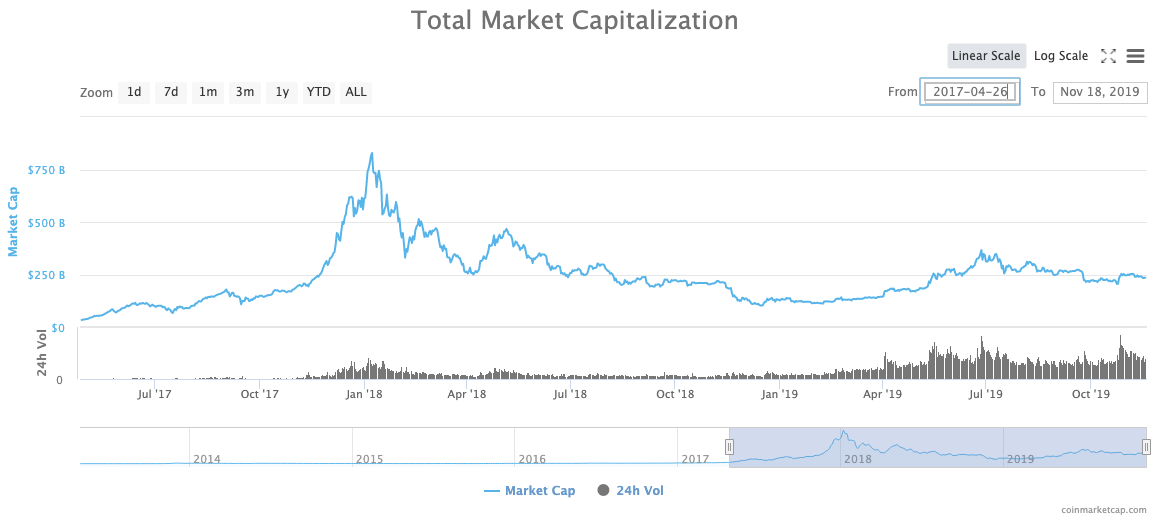 The true crypto-winter may have come and gone last year, and like the final season of Game of Thrones, left many characters from token-funded blockchain projects for dead.
The true crypto-winter may have come and gone last year, and like the final season of Game of Thrones, left many characters from token-funded blockchain projects for dead.
Though overall investment in crypto assets may have recovered to around half their 2017 levels, most of that capitalization (around 65% right now) hinges on the original blockchain, Bitcoin. Cool as BTC may be for the alternative economic thought it generated, this 10-year-old protocol which is largely bought and held rather than used for trade does not represent the promise of blockchain technology for business. (Well, nobody ever accused me of being a Bitcoin maximalist.)
With 3000 or more crypto assets disappearing from awareness altogether, there’s no point in belaboring that companies relying on crypto-funding in the blockchain industry faced hard times. (You can see a 2.5 year chart of overall crypto market capitalization from coinmarketcap.com, below.)
But let’s make one thing clear. While cryptocurrencies generally need to run on blockchain technology, blockchain technology doesn’t necessarily need crypto to perform useful work.
Is blockchain technology still valuable for enterprise use, and does it have the momentum to escape the gravity of crypto-losses?
Before we can answer that question, let’s take a little retrospective tour on how we got here.
From Bitcoin to ETH and ICOs
The value of Bitcoin (BTC) may rise and fall again, but worse for many working in blockchain, the value of Ethereum (ETH) went down even precipitously over the last 2 years, from highs around $1400 to under $100 at times.
Ethereum came onto the scene in 2016, introducing the advance of smart contracts.
While these first smart contracts were neither smart enough, nor detailed enough to be considered legal contracts, they did provide conditional ‘if/then’ statements for the release of tokens tied to the settlement of a transaction – programmable money. This open source project took a big step forward and set the starting point for more mainstream use of blockchain technology in commerce.
Most of the ICO (Initial Coin Offering) projects starting in the last three years raised money not from VCs, but by offering crowdsales of digital tokens, chief among these, the Ethereum blockchain platform’s ERC-20 or ERC-223 token mechanisms.
These tokens were then sold to an eager market of crypto investors, many of whom were flush with value from making very early Bitcoin and Ethereum investments, but struggling to capitalize on the gains without cashing them in for currency.
FOMO (fear of missing out) was so high that some projects like Bancor and Status started selling out of $50M, $100M+ or more of these ERC tokens in days, or even seconds, clogging the Ethereum blockchain mainnet with orders in the process.
Aside from any questions about whether ICO token purchases represented speculative financial securities, this period highlighted a critical architectural shortcoming of blockchain networks for business: the ability to scale to meet peak transaction needs while maintaining consensus across thousands of copies of the same encrypted database.
Feverish interest in the “CryptoKitties” app, which allowed people to buy and breed virtual cartoon cats, famously brought down the Ethereum network’s response times by several minutes or more.
Still, the sky was the limit for blockchain at the end of 2017. You can always blame irrational exuberance and a limited window of time for so many startups entering the market for token-fueled economic engines, but the decline of ETH (and BTC) also caused a huge contraction in funding for blockchain startups.
Though there were a few more high profile sales ahead, the market for new alt-coins cratered in 2018. Perhaps it was because of my skeptic friend Jason Bloomberg calling the whole crypto-fueled ICO process a scam. (Let’s assume it wasn’t Jason, though he may say “told you so.”)
You might think the net result of this would be that enterprises would steer clear of blockchain, but interest and experimentation is still high among many large companies.
What do enterprises need most from a blockchain?
Speed and scale. The open source community leaders of blockchain networks, including the originals ETH and BTC, are already making strides to replace the compute and power intensive methods for solving and settlement with leaner, faster methods for consensus, for instance Bitcoin Lightning channels and new Ethereum and Cardano Proof-of-Stake upgrades, due for production in 2020.
Some newer projects like IOTA and Hedera Hashgraph have moved to a ‘directed acylic graph’ model – that purports to allow thousands of transactions a second against an infinitely sharding number of data nodes, without requiring universal consensus to slow down settlement.
Build it your way. Most enterprise-centric projects no longer tie the blockchain network to crypto at all. Hyperledger, an open source blockchain platform under the Linux Foundation, has been receiving loads of contribution and use from the likes of IBM, Deloitte and Microsoft.
Hyperledger allows companies to build their own public or private permissioned blockchains, and side chains, where data can be shared among known, registered trading partners. You have likely seen a primetime TV commercial about some lettuce farmers using blockchain to verify safe crop delivery to the store — it’s one pilot project the industry has been touting for three years.
By no means are enterprise blockchains limited to lettuce today. Anywhere you have a strong need for multi-party collaboration with a shared, immutable system of record — for instance in logistics and international trade scenarios, media and IP marketplaces, and fields like pharma and aerospace, where the provenance of materials and parts are critical, projects are underway.
Reliability and support. Even larger conventional platform vendors and major consultancies are offering up different forms of DLT (distributed ledger technology), supporting developer education programs and tools, and maintaining a presence on councils in the blockchain world, even if only to hedge their bets in case a breakthrough moment happens.
Blockchain has a built-in advantage when it comes to security and safer identity practices, with most platforms offering strong cryptography and the ability to cordon off permissioned customer and business data on a ‘need to know/need to validate’ basis.
With so many varieties of blockchain now available to the enterprise, the future may be won by the consortium that delivers the best support and education processes, and the legal and financial controls needed for business adoption, rather than the most advanced technology.
The Intellyx Take
It’s like a bank on a blockchain. It’s like Facebook on a blockchain. It’s like Airbnb on a blockchain. It’s like Dropbox on a blockchain. As a token-funded service.
After the crypto winter, the projects that succeed must do better than simply repeating an Internet land grab on blockchain. They will support new business models with speed and scale, customizability, reliability and compliance.
The revolutionary promise of blockchain may still be ahead of us. I believe this upcoming year will offer at least one billion-dollar enterprise application for blockchain technology that delivers on use cases that traditionally designed networks and databases could not.
Any volunteers?
Jason ‘JE’ English is a Principal Analyst at Intellyx. At the time of this writing, IBM is an Intellyx client, and Microsoft is a former customer. None of the other companies or projects mentioned here are Intellyx customers. JE is holding a very small amount of crypto in some of the tokens mentioned above for sentimental reasons. Image credits: Snowcar – Wikimedia Commons; Market overview: Coinmarketcap.com.




Comments
Comments are closed.